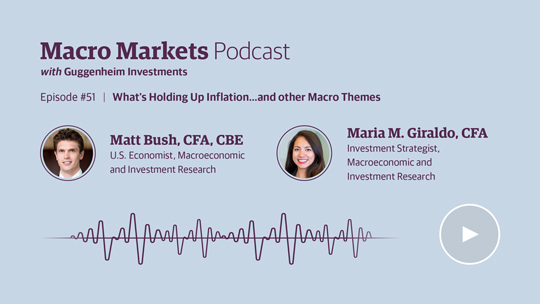/institutional/perspectives/portfolio-strategy/investing-as-the-fed-prepares-to-start-rate-cuts
Portfolio Management Outlook: Investing as the Fed Prepares to Start Rate Cuts
Shifting policy drives uncertainty and opportunity.
As the Federal Reserve (Fed) moves closer to easing and the macroeconomic backdrop persists in sending conflicting signals, we believe the continued high level of volatility in the fixed-income market should reward active management.
From our perspective, several signals of economic information cut through the noise: Inflation is moving in the right direction, as the Fed’s preferred Core personal consumption expenditures (PCE) measure is currently running at less than the targeted 2 percent on a six-month annualized basis; the lagged impact of higher interest rates, along with ongoing quantitative tightening, are showing up at the margins of the economy; bank lending volumes are falling; and commercial real estate stress is building. At the same time, we still have tailwinds from the significant fiscal spending of the last three years as well as continuing massive deficits, recent easing of financial conditions, and the relatively strong financial position of larger companies and wealthier consumers.
Taken together, we believe that the risk of a recession in coming quarters remains higher than average, but it should be a comparatively mild one. At the January FOMC meeting and press conference, the Fed and Fed Chair Jerome Powell injected some uncertainty about the timing of rate cuts, but there is little doubt in the market that cuts are coming.
In this environment, we believe that the investment landscape will continue to reward diversification and higher-quality fixed income. History shows that when the Fed is paused and easing, longer duration higher-quality fixed income has outperformed riskier assets, as well as money market instruments.
Our thinking on portfolio positioning and relative value can be gleaned from the reports by our different sector teams: Spreads generally tightened across all sectors in the fourth quarter as rates fell and favorable technical conditions (strong demand and reduced supply) supported market prices, but all-in yields remain high relative to history. We continue to reduce our exposure to generic credit beta, and instead favor exposure to higher-quality, high carry, low-duration instruments, particularly in non-Agency RMBS, senior CLO tranches, commercial ABS, and short-duration higher-quality high yield. Structured credit opportunities have generally offered less mark-to-market volatility than similarly rated corporate credit, with higher investable yields. We prefer to pick up duration using Agency RMBS given their wider spreads and attractive convexity profile, but longer term we expect the yield curve to bull steepen so we have a marginal bias to increasing our duration exposure to the belly of the curve. We continue to maintain a healthy allocation to short-term investments as dry powder for taking advantage of opportunities as they arise.
—By Anne Walsh, Steve Brown, Adam Bloch, and Evan Serdensky
Important Notices and Disclosures
This material is distributed or presented for informational or educational purposes only and should not be considered a recommendation of any particular security, strategy or investment product, or as investing advice of any kind. This material is not provided in a fiduciary capacity, may not be relied upon for or in connection with the making of investment decisions, and does not constitute a solicitation of an offer to buy or sell securities. The content contained herein is not intended to be and should not be construed as legal or tax advice and/or a legal opinion. Always consult a financial, tax and/or legal professional regarding your specific situation.
This material contains opinions of the authors, but not necessarily those of Guggenheim Partners, LLC or its subsidiaries. The opinions contained herein are subject to change without notice. Forward-looking statements, estimates, and certain information contained herein are based upon proprietary and non-proprietary research and other sources. Information contained herein has been obtained from sources believed to be reliable but are not assured as to accuracy. Past performance is not indicative of future results. There is neither representation nor warranty as to the current accuracy of, nor liability for, decisions based on such information.
Investing involves risk, including the possible loss of principal. In general, the value of a fixed-income security falls when interest rates rise and rises when interest rates fall. Longer term bonds are more sensitive to interest rate changes and subject to greater volatility than those with shorter maturities. During periods of declining rates, the interest rates on floating rate securities generally reset downward and their value is unlikely to rise to the same extent as comparable fixed rate securities. High yield and unrated debt securities are at a greater risk of default than investment grade bonds and may be less liquid, which may increase volatility. Investors in asset-backed securities, including mortgage-backed securities and collateralized loan obligations (“CLOs”), generally receive payments that are part interest and part return of principal. These payments may vary based on the rate loans are repaid. Some asset-backed securities may have structures that make their reaction to interest rates and other factors difficult to predict, making their prices volatile and they are subject to liquidity and valuation risk. CLOs bear similar risks to investing in loans directly, such as credit, interest rate, counterparty, prepayment, liquidity, and valuation risks. Loans are often below investment grade, may be unrated, and typically offer a fixed or floating interest rate.
Guggenheim Investments represents the following affiliated investment management businesses of Guggenheim Partners, LLC: Guggenheim Partners Investment Management, LLC, Security Investors, LLC, Guggenheim Funds Distributors, LLC, Guggenheim Funds Investment Advisors, LLC, Guggenheim Partners Advisors, LLC, Guggenheim Corporate Funding, LLC, Guggenheim Partners Europe Limited, Guggenheim Partners Japan Limited, and GS GAMMA Advisors, LLC..
GPIM 60473
VIDEOS AND PODCASTS

Maria Giraldo, Investment Strategist for Guggenheim Investments, joins Asset TV’s Fixed Income Masterclass.

Matt Bush and Maria Giraldo join the Macro Markets podcast to discuss our newly published Quarterly Macro Themes for 1Q 2024.
©
Guggenheim Investments. All rights reserved.
*Assets under management is as of 3.31.2024 and includes leverage of $14.5bn. Guggenheim Investments represents the following affiliated investment management businesses of Guggenheim Partners, LLC: Guggenheim Partners Investment Management, LLC, Security Investors, LLC, Guggenheim Funds Distributors, LLC, Guggenheim Funds Investment Advisors, LLC, Guggenheim Corporate Funding, LLC, Guggenheim Partners Europe Limited, Guggenheim Partners Japan Limited, and GS GAMMA Advisors, LLC.
By choosing an option below, the next time you return to the site, your home page will automatically
be set to this site. You can change your preference at any time.
We have saved your site preference as
Institutional Investors. To change this, update your
preferences.
United States Important Legal Information
By confirming below that you are an Institutional Investor, you will gain access to information on this website (the “Website”) that is intended exclusively for Institutional Investors and, as such, the information should not be relied upon by individual investors. This Website and any product, content, information, tools or services provided or available through the Website (collectively, the “Services”) are provided to Institutional Investors for informational purposes only and do not constitute a recommendation to buy or sell any security or fund interest. Nothing on the Website shall be considered a solicitation for the offering of any investment product or service to any person in any jurisdiction where such solicitation or offering may not lawfully be made. By accessing this Website, you expressly acknowledge and agree that the Website and the Services provided on or through the Website are provided on an as is/as available basis, and except as partnered by law, neither Guggenheim Investments and it parents, subsidiaries and affiliates nor any third party has any responsibility to maintain the website or the Services offered on or through the Website or to supply corrections or updates for the same. You understand that the information provided on this Website is not intended to provide, and should not be relied upon for, tax, legal, accounting or investment advice. You also agree that the terms provided herein with respect to the access and use of the Website are supplemental to and shall not void or modify the Terms of Use in effect for the Website. The information on this Website is solely intended for use by Institutional Investors as defined below: banks, savings and loan associations, insurance companies, and registered investment companies; registered investment advisers; individual investors and other entities with total assets of at least $50 million; governmental entities; employee benefit (retirement) plans, or multiple employee benefit plans offered to employees of the same employer, that in the aggregate have at least 100 participants, but does not include any participant of such plans; member firms or registered person of such a member; or person(s) acting solely on behalf of any such Institutional Investor.
By clicking the "I confirm" information link the user agrees that: “I have read the terms detailed and confirm that I am an Institutional Investor and that I wish to proceed.”